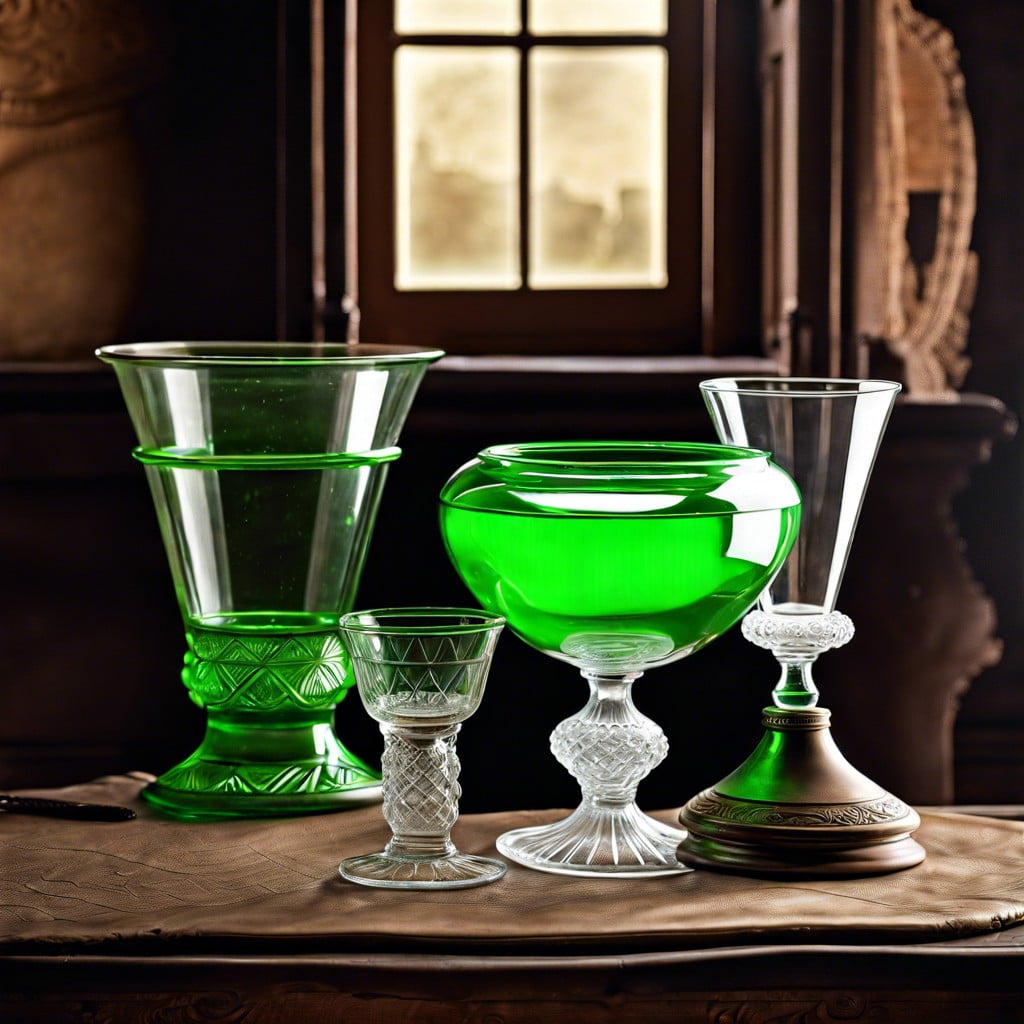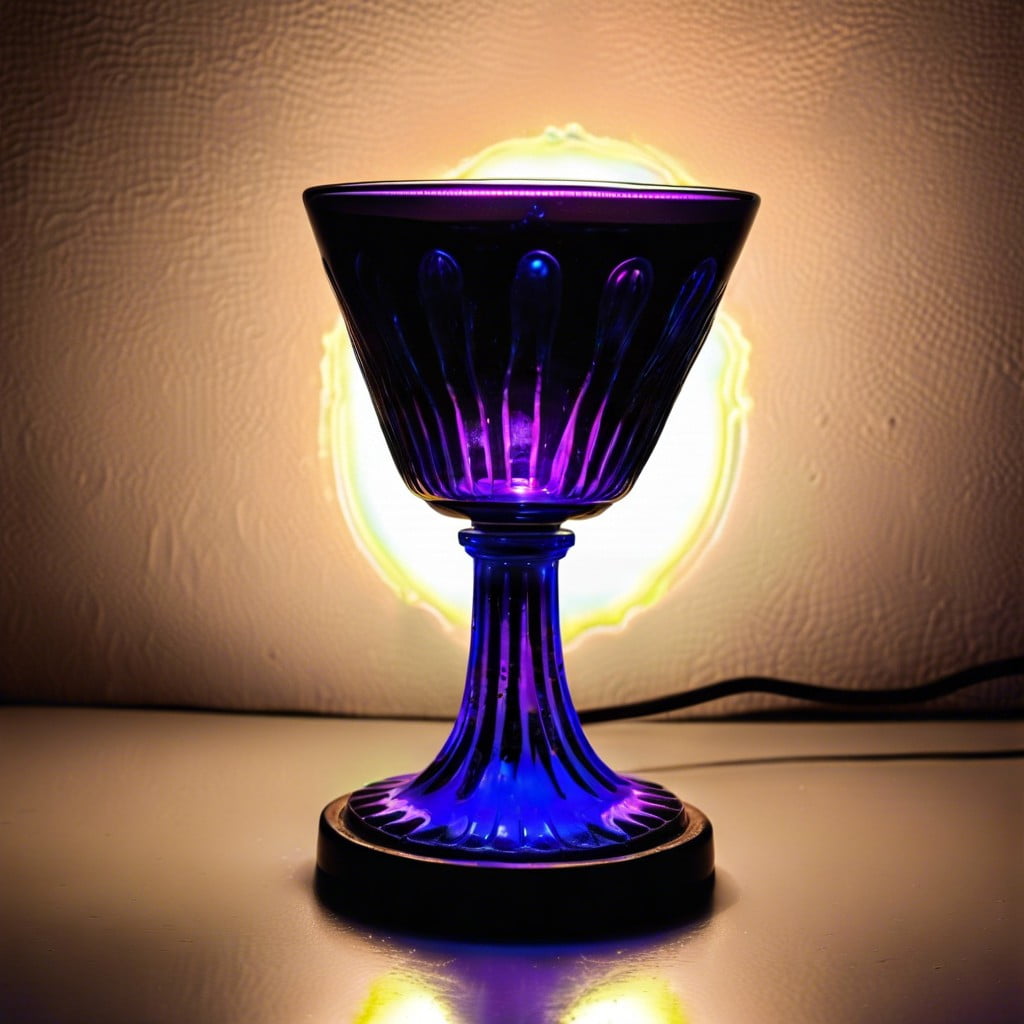Last updated on
Dive into the luminous world of radium glass because its rich history and unique characteristics make it a fascinating subject that continues to glow within the radiant landscape of antique collectibles.
Key takeaways:
- Radium glass gained popularity in the late 19th and early 20th centuries.
- Radium glass emits a faint green glow in low light conditions.
- The creation process involved adding small amounts of radium to glass mixtures.
- Radium glass was used in household items and decorative glassware.
- Responsible handling and safety measures are essential when dealing with radium glass.
History of Radium Glass

Radium glass, a unique type of glassware, gained popularity in the late 19th and early 20th centuries, particularly during the Art Deco period. Its creation was facilitated by the discovery of radium by Marie and Pierre Curie in 1898, which sparked a fascination with radioactivity and its potential applications.
Manufacturers added small amounts of radium to glass mixtures, bestowing a characteristic green glow and a sense of novelty to the items. This glowing feature was especially appealing for items like clock faces and decorative objects, as they could be seen in the dark.
Production peaked in the 1920s and 1930s when the consumer market was captivated by the novelty of radioactive materials without a full understanding of their health implications. The decline in the production of radium glassware began as the risks associated with radioactivity became more evident and alternative, safer luminous materials were developed.
Distinguishing Characteristics

Radium glass, often recognized by its distinctive pale greenish-yellow hue, emits a faint glow in low light conditions due to the radioactive elements it contains. This luminescence is best observed in a darkened environment. The coloration and brightness can vary significantly dependent on the amount of radium present during production.
The surface of radium glass typically features a subtle iridescence, which, coupled with its unique glow, differentiates it from non-radioactive glassware. The thickness of the glass may also impact the intensity of its luminescence. Additionally, when exposed to ultraviolet light, such as that from a black light, radium glass can exhibit a more pronounced fluorescence, further aiding in its identification.
Fabrication Process
The creation of radium glass involved incorporating small amounts of radium into the glass mixture to give it a distinctive glow. This process was primarily popular in the early 20th century before the dangers of radium were fully understood.
- Raw materials, typically silica sand, potash, and lime, were mixed together and melted at high temperatures.
- Radium sulfate or chloride was added to the molten glass to achieve the desired luminosity.
- The radium-infused glass was then molded or blown into various shapes and sizes, ranging from decorative figurines to utilitarian items like tableware or clock faces.
- As the molten glass cooled, the radium remained embedded within the glass matrix, emitting a faint glow, especially under ultraviolet light.
Usage in Antiques
Historically, radium glass, known for its subtle green glow, was frequently incorporated into the production of household items, adding an element of novelty and modernity to the early 20th-century home.
These collectible antiques range from decorative glassware, such as vases and figurines, to utilitarian objects including clocks, watches, and instrument dials.
These pieces were not only admired for their unique luminescence but also believed to confer health benefits—a notion later debunked and now recognized for its potential danger.
Collectors today seek out these antiques for their historical significance and distinctive appearance, making them desirable additions to collections of early industrial-era artifacts.
However, it is crucial for enthusiasts to understand the risks associated with radium and handle these antiques with care.
Health Concerns
While radium-enhanced glassware boasts an intriguing historical allure, its radioactive nature warrants a discussion of health implications. Prolonged exposure to radiation, even at low levels, raises the risk of certain cancers. However, the radiation emitted by these antiques is relatively low, and occasional handling is considered safe by experts.
The greater concern lies with ingestible items, such as uranium-glazed dinnerware, which can leach small amounts of radionuclides into food and beverages. Given that the human body does not distinguish radium from calcium, radium can be deposited in bones, posing a more serious health risk over time.
Collectors are advised to keep radium-containing antiques on display and to avoid using them for food consumption. It’s important to note that radium’s half-life—a measure of the time taken for half its radioactivity to decay—is 1,600 years, which means that these items still retain much of their original radioactivity. When handling, consider protective measures like gloves, and always wash hands afterwards. Keeping such items out of children’s reach is also a prudent measure, given their increased sensitivity to radiation.
Estimates of the Radiation Exposures
Radiation exposure from radium glass varies depending on the item’s size, age, and radium concentration. While levels may be relatively low, prolonged exposure, especially in close proximity, could be of concern.
A few points to consider:
- 1. Measurement units for radiation include becquerels (Bq), which quantify radioactivity, and sieverts (Sv), which measure exposure impact on the body.
- 2. Typically, radium in glassware emits alpha particles, which have low penetration and are a minimal risk if the glass remains intact.
- 3. Exposure can increase if the glass is damaged, as particles might be inhaled or ingested.
- 4. Compared to other sources of natural background radiation, such as radon gas in homes or cosmic rays at high altitudes, radium glass usually contributes a negligible increase in radiation dose.
- 5. Individuals interested in obtaining precise measurements of their radium glass items can consult with professionals using Geiger counters or other radiation-measuring devices.
Pertinent Regulations
Following its heyday in the early 20th century, concerns around the safety of radioactive materials led to significant updates in regulatory measures. The United States Nuclear Regulatory Commission (NRC) and the Environmental Protection Agency (EPA) have since established guidelines that limit the use of radioactive materials, including those that could be found in radium glassware. Items manufactured before these regulations, mainly pre-1960s, can still be legally sold and owned, yet their production today would require adherence to strict contemporary safety standards.
In the European Union, similar standards are in place. The Euratom Treaty governs the safe use and disposal of radioactive materials. Additionally, strict import and export rules apply to potentially radioactive antiques, ensuring compliance with international safety standards.
Antique dealers and collectors should be aware of their respective national health and safety guidelines, which may affect the sale, acquisition, or possession of radium glass artifacts. It is also advised to be knowledgeable of the guidance surrounding transport, as mailing such items may be subject to regulation due to their radioactive nature.
How to Identify Radium Glass
To accurately identify radium glass, consider the following indicators:
1. Appearance: Radium glass commonly exhibits a pale green to a greenish-yellow color when observed under normal lighting conditions.
2. Ultraviolet Light Test: Under UV light, also known as a blacklight, radium glass will fluoresce due to the radioactive content, revealing a distinctive green glow.
3. Geiger Counter Test: A Geiger counter can detect the presence of radiation and is a surefire way to confirm the presence of radium. However, it’s advisable to have a professional perform this test, as they can interpret the readings accurately.
4. Age and Context: Most radium glass was produced during the early 20th century, especially from the 1920s to the 1930s. Knowing the context and age of the piece can be a strong indicator of its authenticity.
5. Markings and Maker’s Marks: Researching markings or stamps on the glassware can provide insights into its origins. Some pieces may have the manufacturer’s marks that are associated with known radium glass producers.
Consulting with antique experts or utilizing resources on vintage glassware can provide additional context and increase the likelihood of proper identification.
The Value of Radium Glass
Several factors contribute to the valuation of radium glass, a collectible antique. Rarity plays a significant role; pieces produced in limited quantities or with unique designs fetch higher prices. Condition is also crucial, with well-preserved items without chips or cracks being more desirable. The color of the glass, often a pale green due to the radioactive content, can vary in intensity and thus, affect value. Certain patterns and manufacturers are sought after by collectors, creating a premium for these items. Historical significance, such as pieces dating from the peak of radium popularity, adds to the allure and monetary worth. It is important to note that while radium glass has collectible interest, the market is niche, and values can fluctuate based on collector demand and public awareness of radiation safety.
Safety Measures for Collectors and Owners
Responsible handling is paramount when dealing with items composed of radium glass to minimize exposure to radiation:
1. Limit Direct Handling: Use gloves or employ tools to handle radium glass, thereby reducing direct contact with skin.
2. Display Safely: Store or display radium glass behind glass to serve as a barrier against any potential alpha and beta radiation.
3. Maintain Distance: Keep radium glass pieces at a distance from frequently occupied areas to lower the dose of gamma radiation absorbed.
4. Short Viewing Times: Appreciate radium glass collections in limited durations to minimize radiation exposure time.
5. Use Geiger Counters: Employ radiation detection instruments like Geiger counters to monitor the levels of radiation emitted by the artifacts.
6. Educate Yourself: Stay informed about the safety guidelines provided by health and radiation safety authorities.
By adhering to these points, collectors and owners can enjoy the historical and aesthetic value of radium glass while ensuring personal safety.




